Glasshayes House: the 1912 extension of The Lyndhurst Grand Hotel

The Arthur Conan Doyle Collection Lancelyn Green Bequest (Portsmouth) has in its archives some design sketches drawn in 1912 by Arthur Conan Doyle. Brice Stratford, author of "Glasshayes House: A History of the Former Lyndhurst Park Hotel", studied the sketches and found they were related to the 1912 extension of Glasshayes House, The Grand Hotel, located in Lyndhurst, The New Forest, Hampshire, UK.
Since 1970 the building is known as Lyndhurst Park Hotel.
As of september 2017, the hotel is unfortunately scheduled for demolition.
Arthur Conan Doyle and Glasshayes House
Arthur Conan Doyle was, it is no exaggeration to say, a man of many talents and many more interests. A great deal of these passions, missions, dabblings and whims have been thoroughly documented, but there still exists a steady supply of untrammelled aspects of the man's life and work, specifically surrounding his mellifluous jaunts into fields in which he found himself a capable, well-informed amateur. One such jaunt, which I will write about here, is his (apparently hitherto unknown) foray into architecture; I refer not to Undershaw, the family home he built in Surrey, but to the New Forest hotel which he personally designed an entire third floor extension and new facade for. A third floor and facade which survive, battered but recognisable, to this day. I refer to the Lyndhurst Grand Hotel.
When the early 19th century mansion of Glasshayes House in Lyndhurst, New Forest, was sold off by it's final privately residential owner (Colonel Alexander Caldcleugh Macleay) in 1895, the estate was apportioned into various lots, with the House itself repurposed as a prospective "Grand Hotel." This opened soon after, structurally unchanged, with relatively minor building works and alterations carried out sporadically over the following fifteen years. [1] Throughout this time the overall building was very recognisably the same one as it had been since the 1846 redesign carried out by the then owner, the first Duc de Stacpoole. Even prior to these works the building's signature features (a Georgian Gothick castellation, stuccoed walls and an octagonal smugglers lookout tower) had been present from its first incarnation, constructed somewhere between 1806 and 1826. [2] This all changed in 1912, with the addition of another floor to the East wing, and a concomitant redesign of the front entrance by a total amateur. I speak, of course, of Sir Arthur Conan Doyle.
Conan Doyle had long had an association with the New Forest, having spent considerable time around the Lyndhurst and Minstead area researching his famous New Forest book The White Company, published in 1891. He would later buy a country home at Bignell Wood, near Minstead (which borders Lyndhurst), for the birthday of his second wife, Jean (both of whom are buried in the cemetery there, having been reinterred from Crowborough at their posthumous request in 1955). [3] Even Doctor Watson trained at nearby Netley Hospital, and often "yearned for the glades of the New Forest." [4]
The family trip which lead to this bout of amateur architecture had taken place early in the year, starting either late February or at the very beginning of March. By March 3rd Conan Doyle was staying at the Lyndhurst Grand Hotel, and wrote a letter from there to the Daily News (titled "Rubber Atrocities," published March 5th in response to a Mr. D. MacCammond). Photographs of the holiday (and of Conan Doyle himself on the trip, alongside places they visited and stayed) can be found in an album at the Lancelyn Green Archive, held in the Conan Doyle Collection at Portsmouth Central Library, each clearly labelled and dated distinctively by Jean, Conan Doyle's second wife. [5]
It's in this same archive, in one of many scrap books collected by J. L. Weir throughout the 1970's and early 1980's, that some of Conan Doyle's original sketches for the extension can be found. [6] A single page from a sketchbook slightly larger than A4, drawn on both sides, it depicts a range of designs for the northern view of the East wing; specifically the front entrance and its aesthetic. About five related variations are depicted, with one concept in particular seeming to evolve from the others and becoming very much the conclusory focus; it was this main version which was chosen for the extension work, and which survives recognisably today.
Though it may, at first, appear a bold move for Conan Doyle to offer up designs for a provincial hotel extension, it isn't entirely unprecedented. A noted and creative polymath himself, Conan Doyle's father had been a surveyor for the Scottish Office of Works and held ambitions as an architect, describing himself as such on his marriage certificate of July 31st 1855, and in the 1881 census. Conan Doyle's close friends also pursued careers in architecture, and he would certainly have been familiar with and open to the practice. [7] When he commissioned the building of a Surrey home, Undershaw, from one of these friends (the architect Joseph Henry Ball) "Doyle had a hand in the designs," [8] sketching and explaining his (as he called them) "ideas for the house" in a letter to his mother from May 5th of 1895. [9] In 1914 when on another family trip, just two years after the Glasshayes designs, he took it upon himself to design a golf course and related outbuildings for "a million dollar hotel" in Canada's Jasper National Park (this was built according to his plans, but has not survived). [10] Taken in context, the Glasshayes sketches are, if not predictable (what about Doyle is?), certainly within the remit of his character and abilities.
According to the designs, which are dated and validated as Conan Doyle's by his wife Jean, they were sketched out for a Miss Ryland, who was the manageress [11] of the hotel by 1911 and continued in that position into the 1920's. [12] It seems likely that Conan Doyle had been given the specific prerequisite of incorporating another floor into the East wing as it stood, with all five variant designs based around this alteration. This need not have been anything more than a casual endeavour on Conan Doyle's part; a fun afternoon's whim in response to a passing conversation with the management of a hotel he happened to be enjoying.
Documents in the Hampshire Record Office which relate to the Lyndhurst Grand Hotel in the early 20th century specify that the work based on "Doyle's plans" began in "Autumn 1912" (see photo) [13]. If Conan Doyle's designs were delivered during his stay there in March, they could easily have been reviewed and adapted by the architect over the Spring, with building work finalised and planned during the Summer, to take place come Autumn in the "off-season" when fewer tourists would be around to disrupt.
Conan Doyle returned regularly to the New Forest, and in visiting his home near Minstead would never have been too far from the hotel. A photograph of Conan Doyle's fifteen year old son Denis playing cricket at the Bolton's Bench green (just a couple of hundred yards from the hotel) exists from August of 1924, [14] and on the 5th of June, 1925, Conan Doyle was staying again at the hotel he had helped redesign, writing in a letter to Denis: "Here we are with memories all around us – both rather weary." [15]
Conan Doyle's Plans in Detail
The surviving page has, apparently, been torn cleanly from a sketchbook. Both sides have been drawn on extensively, and so I will treat them as pages 1 and 2 (Page 1 with the torn side to the left, Page 2 with the torn side to the right, numbered as if the leaf were still in a book and turned for reading). It is likely that Conan Doyle would have sketched in this order, meaning the sketches of Page 1 should be read as leading directly on to the sketches of Page 2.
Page 1 consists of eleven sketches of the Glasshayes building of various sizes and detailing (see photo). Eight of these sketches are small outlines of Glasshayes, both as it stood at the time of drawing (in its pre-1912 state) (see photo) and as concept designs for four different extensions. Of the remaining sketches, one is a large outline of an extension design, one is a large and detailed sketch of the extension design which was eventually chosen, and the other is a mid-sized sketch which compares the outline of the pre-1912 building with one of Conan Doyle's ideas for raising it. Also depicted on Page 1 are a sketch of a shield with a single chevron, a sketch of a small turret, and a sketch of a similar shield between two similar turrets, which seems to be an early design for the ornamental detailing which survives today at the roof atop the front entrance of Glasshayes House (see photo).
Page 2 consists of six sketches of the Glasshayes building, and two inscriptions (see photo). Of the six sketches; two are medium sized outlines comparing the building as it stood at time of drawing with potential extension outlines (including an additional design concept, raising the total depicted to five), two are medium sized detailed sketches of potential extensions (one of which depicts the extension as it was built and as it survives today), one is a small sketch of the outline of the building as it was finally extended, comparing its levels, incline and height variations with those of the neighbouring "Bolton's Bench" hill landmark. The final sketch is an especially large depiction of the East wing extension design that was eventually chosen (see photo) (and which survives to this day) (see photo) drawn with a ruler and displaying some detailing, as well as including the height variations of the building as it existed at the time of drawing for contrast (see photo). Of the inscriptions, one is in Conan Doyle's hand (though rough and careless, likely a quick and thoughless note to himself) and reads "Grand Hotel ideas for Ms. Ryland" (Miss M. E. Ryland was, according to the 1911 Kelly's Directory, the then Manageress of the hotel), the other is in the bottom right hand corner and simply reads "ACD 1912" - this second inscription is written in the hand of Conan Doyle's wife, Jean, and matches well with similar inscriptions she made on other documents from that trip (ACD standing for Arthur Conan Doyle). [16]
Both pages 1 and 2 are written/drawn entirely in pencil, on coarse paper. The document has been creased and slightly torn (in the middle and on the sides), but these dog-ears do not obscure the contents.
Analysing Conan Doyle's Designs
Conan Doyle seems to have begun by sketching the rough outline of the building as it stood at the time of drawing (its pre-1912 iteration, as verified by a surviving photograph dated to around 1900), (see photo) and experimenting with ways to raise the intended height variations in order to incorporate a new floor, but whilst maintaining a cohesive (if new) aesthetic design.
In sketching out different concepts Conan Doyle has clearly sought to maintain his own interpretation of the decorative Glasshayes castellation, and to incorporate portions of the original house unchanged (specifically the far-eastern bay windowed section, which is common across all his designs and which survives today) (see photo). His primary and defining focus appears to be the building silhouette/outline and its height variations, with features such as window placement, decoration, and the retention of the castellated porch as secondary concerns. A recurrent theme is the idea Conan Doyle had for an upward and asymmetrical incline, from east to west, defining this front entrance portion of the building; he regularly draws diagonal lines over the sketches to emphasize this, and on Page 2 actively demonstrates the intention that this shallow incline should, symbolically, mirror the locally famous Bolton's Bench hill landmark, which sits directly to the east of the hotel (see photo). Bolton's Bench is exceptionally well known, both from within the New Forest and as a tourist destination, and so to combine the hotel design with this natural feature of the landscape is understandable and inspired, and very much in keeping with Conan Doyle's preoccupations.
Though Conan Doyle has sketched out five different ideas for the extension, they are not all given equal weight. Indeed, it seems that a lot of the small outline sketches are experimental thoughts leading up to the specific design he draws larger (and with detailing), which then evolves into the final design, which he has drawn the most often with the most detailing and effort, not to mention in the largest size. It is, unsurprisingly, this final design (which we can take as the culmination of the thoughts he was sketching out in the document) which was chosen and used by the architect, and which survives visibly today. Indeed, on the larger, detailed, middle sketch of Page 1 we can see that Conan Doyle had originally sketched a different design than that settled on, and that he actively altered this sketch to incorporate the ideas which would develop it into the final design (specifically the addition of ornamental turrets and blazon atop the front entrance, the distinction and slight increase in height of the block immediately to West of the entrance block, and even the possibility of removing it's crenellations, culminating in a small pseudo-turret peak to the West). Whilst experimenting with this design, Conan Doyle has sketched out a couple of other small outlines for it which emphasize the significance of this segmented but gradual height increase, and on Page 2 has almost exclusively focused on better explicating it through multiple sketches of varying detail. Page 2 (presumably sketched after the work of Page 1) seems a clear conclusion of Conan Doyle's thoughts on the subject, and very much settles on the design which was chosen, built, (see photo) and which almost entirely survives today (see photo) – even down to the placement of windows and the understated decorative plasterwork around each one.
Conan Doyle's sketches clearly depict the building in its pre-1912, unaltered state (see photo). Alongside these sketches he also experiments with a range of different extension forms, with only one of the multitude he provides accurately representing the extension as it was finally built (see photo). If this internal evidence were not sufficient, period documentation held in the Hampshire Record Office clearly specifies the extension work as having begun in "Autumn [of] 1912," and as following "Doyle's Plans." (15) We know that Conan Doyle's sketches date to early March of 1912, so even if the period documentation (through some extraordinary coincidence) referred to a different "Doyle" it would not explain how Conan Doyle had predicted the extension so perfectly a full six months prior to its construction commencing (see photo). Even without taking into account Conan Doyle's vague reference to it thirteen years later, the cumulative evidence makes the conclusion of Conan Doyle's designing of the extension quite unambiguous; [17] any questions as to whether Conan Doyle might merely have sketched the hotel after the building work had been completed, rather than supplying the original aesthetic design, can therefore be easily allayed. When one has eliminated the impossible, all that remains, however improbable, must be the truth.
Conan Doyle's Design in Practice
Though Conan Doyle's chosen design was adhered to quite faithfully by the architect, certain minor changes were brought about in the transition from paper to mortar. The segmented and asymmetrical increase in height from East to West, which Conan Doyle focused on so actively, has very much been kept, though perhaps slightly shallower than Conan Doyle had sketched. Conan Doyle specifies a flag at the pseudo-turret peak, but it is not clear if one ever flew (no depictions portray it). Conan Doyle did not include any visible chimneys in his design, though a number were added by the architect in a style which reflected the crenellations of Conan Doyle's ornamental turrets. The decorative additions Conan Doyle specifies (around windows, and the shield/turret feature atop the entrance way) have been actively included, though subtly reinterpreted in practice.20 Whether all of Conan Doyle's crenellations were included is unclear, though possible; not all of these survive (though the loss is not major) (see photo).
Essentially, Conan Doyle's design has been adhered to closely; steadily inclining height variation, a modified reinterpretation of the castellation, window placement, the incorporation of unchanged original portions, decorative features and segmentation have all been transferred almost perfectly from concept to construction. Despite the loss of the castellated porch (which likely dated to the 1868 alterations of the owner Charles Castleman, since been replaced by an unsympathetic late 20th century box entrance), (see photo) and the loss of some of the decorative crenellation (easily restored, and not a structural loss), the building exterior has otherwise survived almost exactly as Conan Doyle's designs dictate. Though the building has suffered a severe loss of chimneys since the 1912 extensions, as none are depicted in the Conan Doyle sketches this can't really be considered as detracting from Conan Doyle's intended design. In the same vein, though much alteration has been suffered by West wing of the building since 1912, (see photo) none of this portion was included in Conan Doyle's sketches or redesign, and so these alterations cannot be considered as diminishing the surviving building as he designed and intended it. Though no sketches are present which depict ideas (if any) Conan Doyle may have had for the southern view of the East wing, the retention of the original octagonal tower is very much in keeping with his design concept, and the castellations and raised levels seem to follow his designs for the northern view closely (see photo). This South-eastern portion has also survived relatively unchanged since the 1912 extension, with almost all the decorative crenellations intact. (see photo) The only real alteration has been the addition of a late 20th century conservatory, which has resulted in no significant loss of original material or change to the structure of the building; all other alterations, additions and extensions have occurred to the West wing, which was apparently not relevant to, or a part of, Conan Doyle's redesign (his focus being on the front entrance portion of the East wing – unsurprisingly, when one considers this to be the most publicfacing part of the building's facade).
Conclusion
I have, quite clearly, demonstrated the evidence which indicates that Sir Arthur Conan Doyle designed the major 1912 East wing extension to the Grand Hotel, Lyndhurst (also Glasshayes House, later the Lyndhurst Park Hotel). I have also demonstrated that the East wing extension conceived in this redesign by Conan Doyle was (for all intents and purposes) the East wing extension that was successfully realised in construction, and that the building as conceived of in these designs not only existed after the building work was concluded, but also recognisably exists today. Factoring in the loss of decorative crenellations and the absent castellated porch (alongside later minor and negligible alterations), approximately 80-90% of the exterior that Conan Doyle designed (and would have actively recognised as his own) remains recognisable and intact today. Sir Arthur Conan Doyle, almost ninety years after his death, is still a hugely celebrated and influential figure around the world; as his 1914 hotel golf course development no longer exists, and his cursory initial explorations into architecture with Undershaw in 1895 were considerably less involved, I am confident in stating that this is a significant survival of a building with historic and architectural significance of a unique kind, on both a national and potentially international scale.
Photos
Northern View of East Wing (front entrance, ca. 1900)

Details from Conan Doyle's sketches comparing height incline with Bolton's Bench, depicting height development from pre-1912 incarnation, and a detailed example of final design
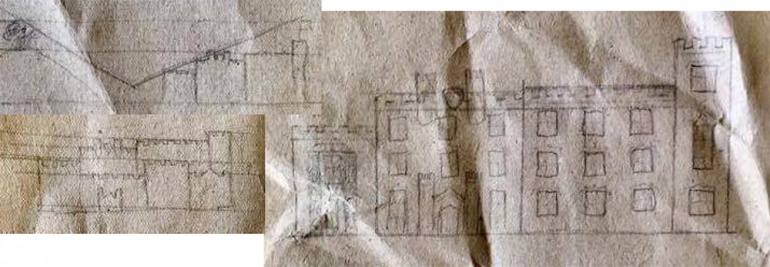
Northern View of East Wing (front entrance, post-1912 Conan Doyle extension)

Northern View of East Wing (front entrance, post-2010)
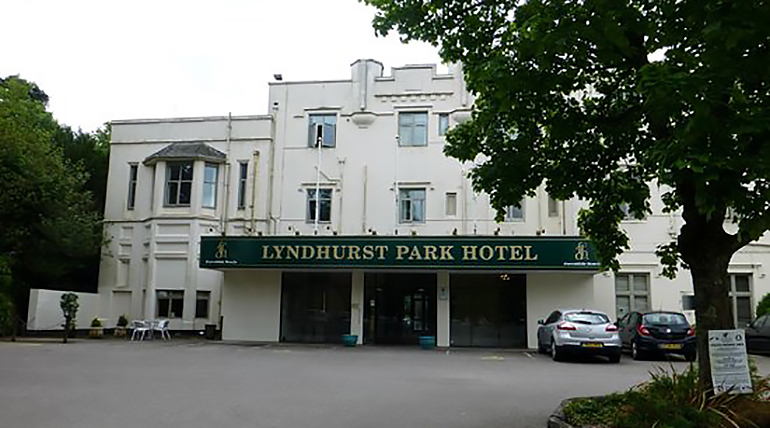
Northern View of East Wing (front entrance, post-2010)
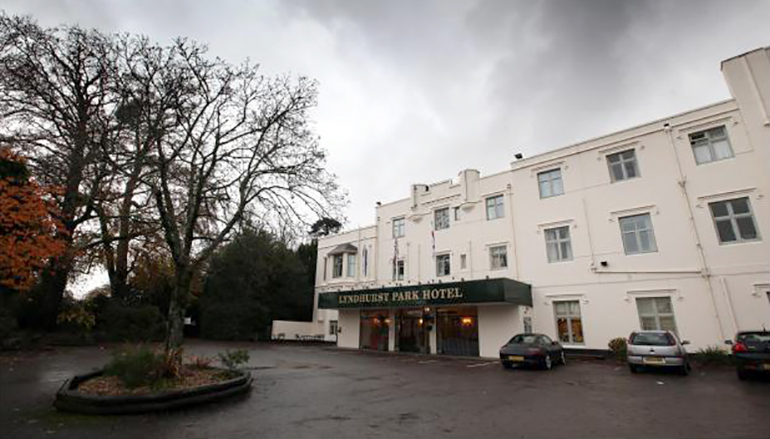
Southern View of Crenellated Bay Window Section, 2017 (early-mid 19th century. Survival)
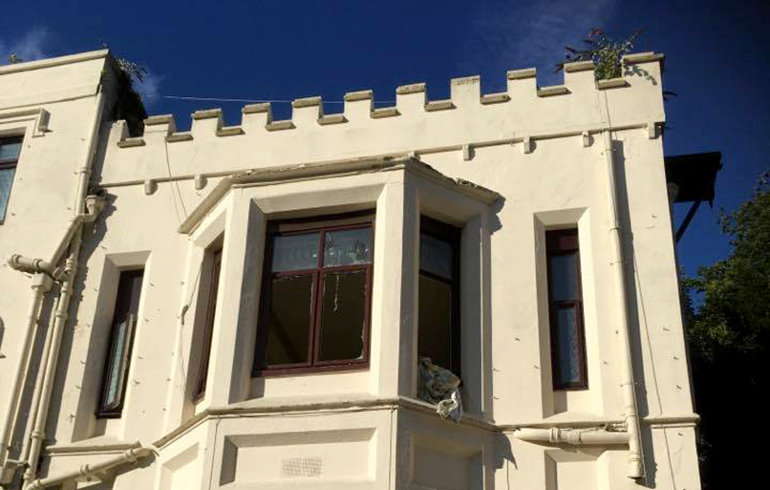
Southern View of East Wing (1845)
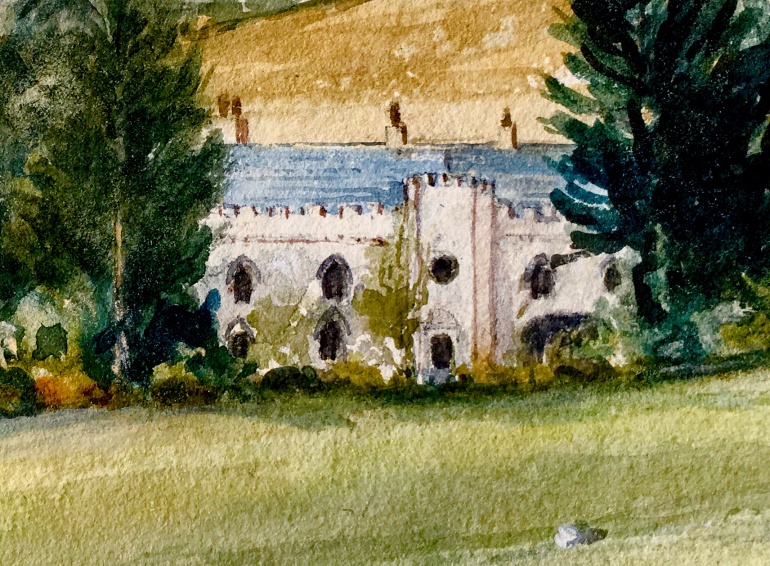
Southern View of East Wing (ca. 1900)

Southern View of East Wing (post-1912 Conan Doyle Extension)
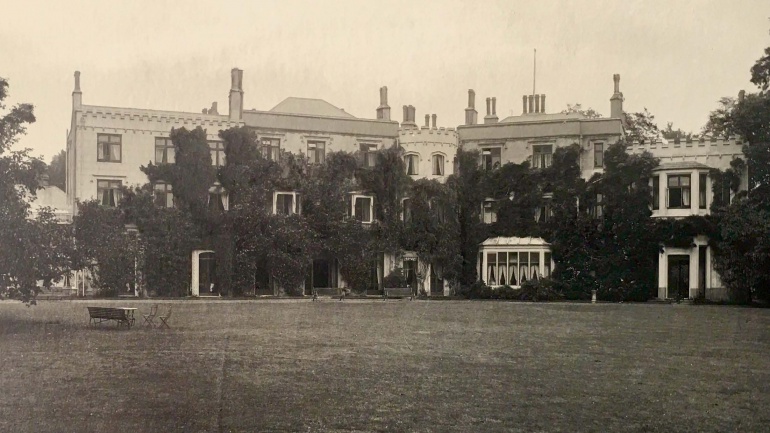
Southern View of East Wing (2017)
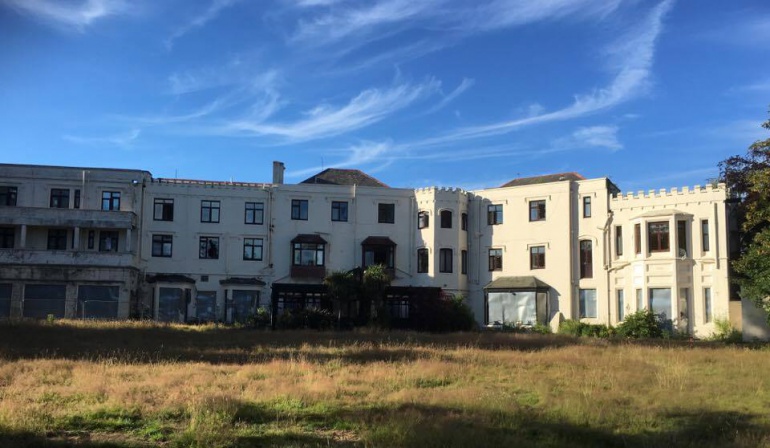
North-West View of West Wing post-2010 (Mid to Late 20th century additions)

Detail from documents relating to sale of the Grand Hotel (25M55/73, Hampshire Record Office) specifying and dating "Doyle's Plans" and their construction.
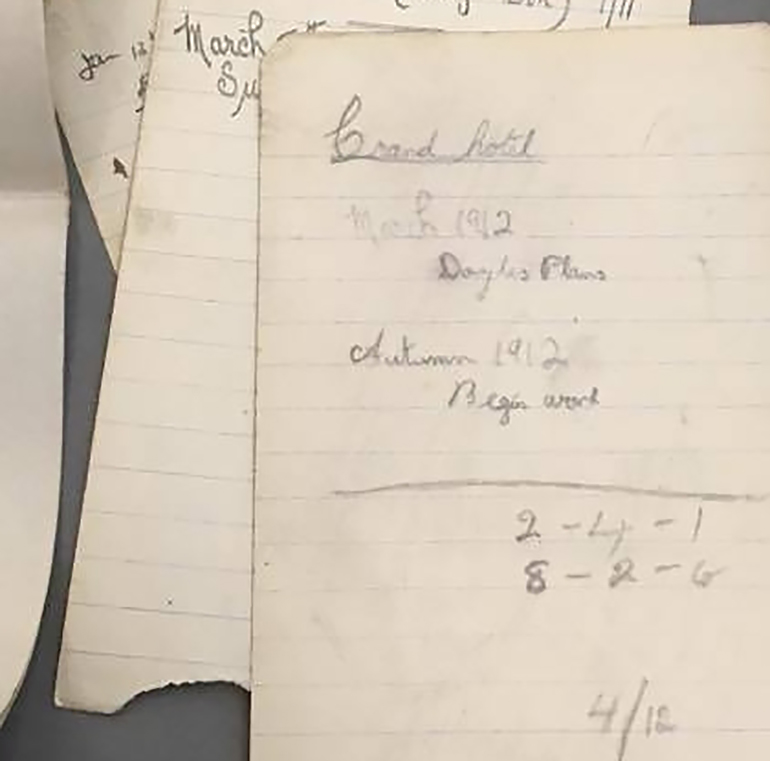
Page 1 of Conan Doyle's design sketches
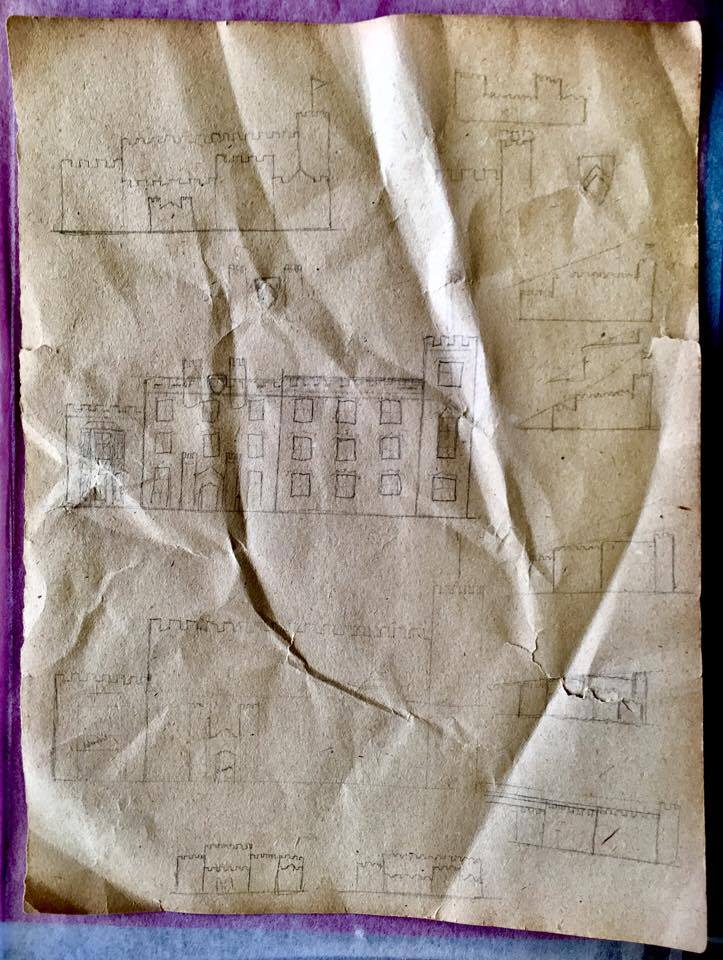
Page 2 of Conan Doyle's design sketches
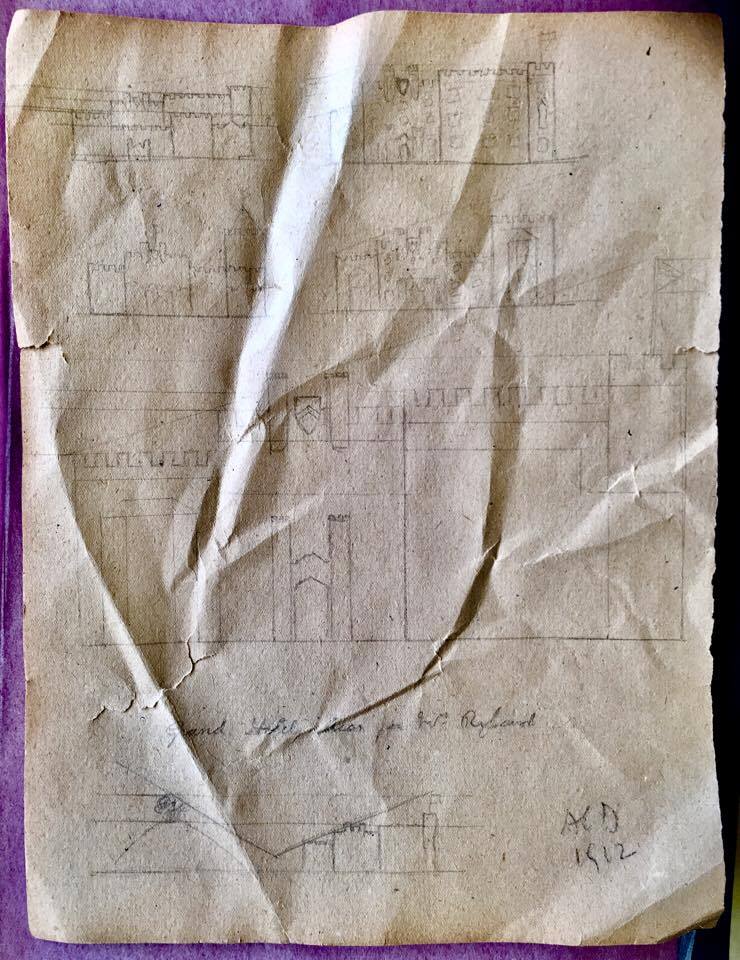
Notes
- ↑ Stratford, Brice, 2017, Glasshayes House: A History of the Former Lyndhurst Park Hotel (Part One: 1728-1895), Christopher Tower Reference Library, New Forest Centre, p.8.
- ↑ Stratford, Brice, 2017, Glasshayes House: A History of the Former Lyndhurst Park Hotel (Part One: 1728-1895), Christopher Tower Reference Library, New Forest Centre, pp. 1-2.
- ↑ New Forest National Park Authority, accessed 2017, Arthur Conan Doyle: the Creator of Sherlock Holmes, "Forest Folk."
- ↑ Conan Doyle, Arthur, 1892, The Adventure of the Cardboard Box, The Strand Magazine, London.
- ↑ Conan Doyle, Jean, 1912, Album of Travel Photographs, ACD1/B/1/1/9/20-29, Conan Doyle Collection, Portsmouth Central Library.
- ↑ Weir, J L, c.1977, Scrapbook from the Collection of J L Weir containing documents relating to collecting activities, ACD1/I/2/32, Conan Doyle Collection, Portsmouth Central Library.
- ↑ Cooke, Simon, 2013, Introduction: Life and Controversy, "Charles Altamont Doyle," The Victorian Web.
- ↑ Historic England, 1977 (amended 2014), Reasons for Designation – Architectural Interest, "Undershaw List Entry," 1244471, National Heritage List for England (NHLE).
- ↑ Conan Doyle, Arthur, 1895, Letter to Mary Doyle May 25 1895, "A Life in Letters," 2007, Edited by John Lellenberg et al, HarperPress, pp. 352-355.
- ↑ The Golfball Factory, accessed July 2017, Sir Arthur Conan Doyle – Golf Course Architect.
- ↑ Kellys Directory of Hampshire, 1911, "Grand Hotel," Lyndhurst, p. 278.
- ↑ Kellys Directory of Hampshire, 1926, "Grand Hotel," Lyndhurst, p. 283.
- ↑ Various, 1907-1913, Agreement for Sale of Grand Hotel, etc., 25M55/73, "55025 - Dibden, Lyndhurst etc. deeds," Hampshire Record Office, Winchester.
- ↑ Conan Doyle, Jean, August 1924, Photograph of Denis Conan Doyle at Lyndhurst Cricket Ground, ACD1/B/1/7/113, Conan Doyle Collection, Portsmouth Central Library.
- ↑ Conan Doyle, Arthur, June 1925, Letter from Arthur Conan Doyle to Denis Conan Doyle, with Envelope, ACD1/B/2/1/5, Conan Doyle Collection, Portsmouth Central Library.
- ↑ Conan Doyle, Jean, 1912, Album of Travel Photographs, ACD1/B/1/1/9/20-29, Conan Doyle Collection, Portsmouth Central Library.
- ↑ Conan Doyle, Arthur, June 1925, Letter from Arthur Conan Doyle to Denis Conan Doyle, with Envelope, ACD1/B/2/1/5, Conan Doyle Collection, Portsmouth Central Library.
- Credits: © Brice Stratford.